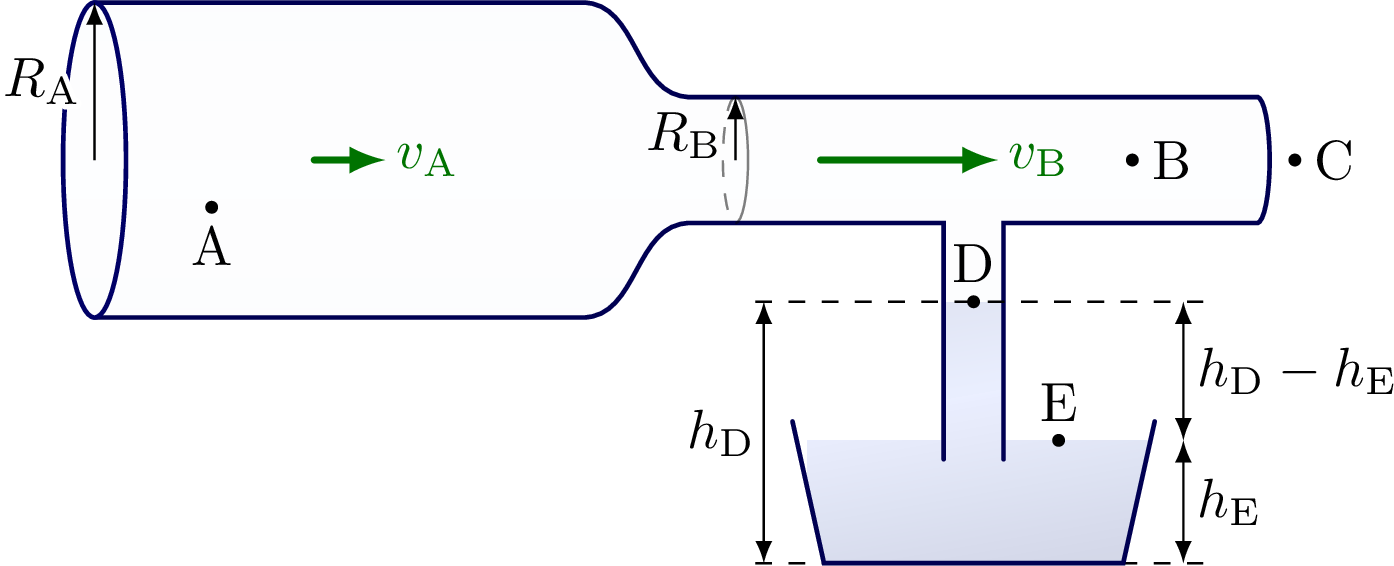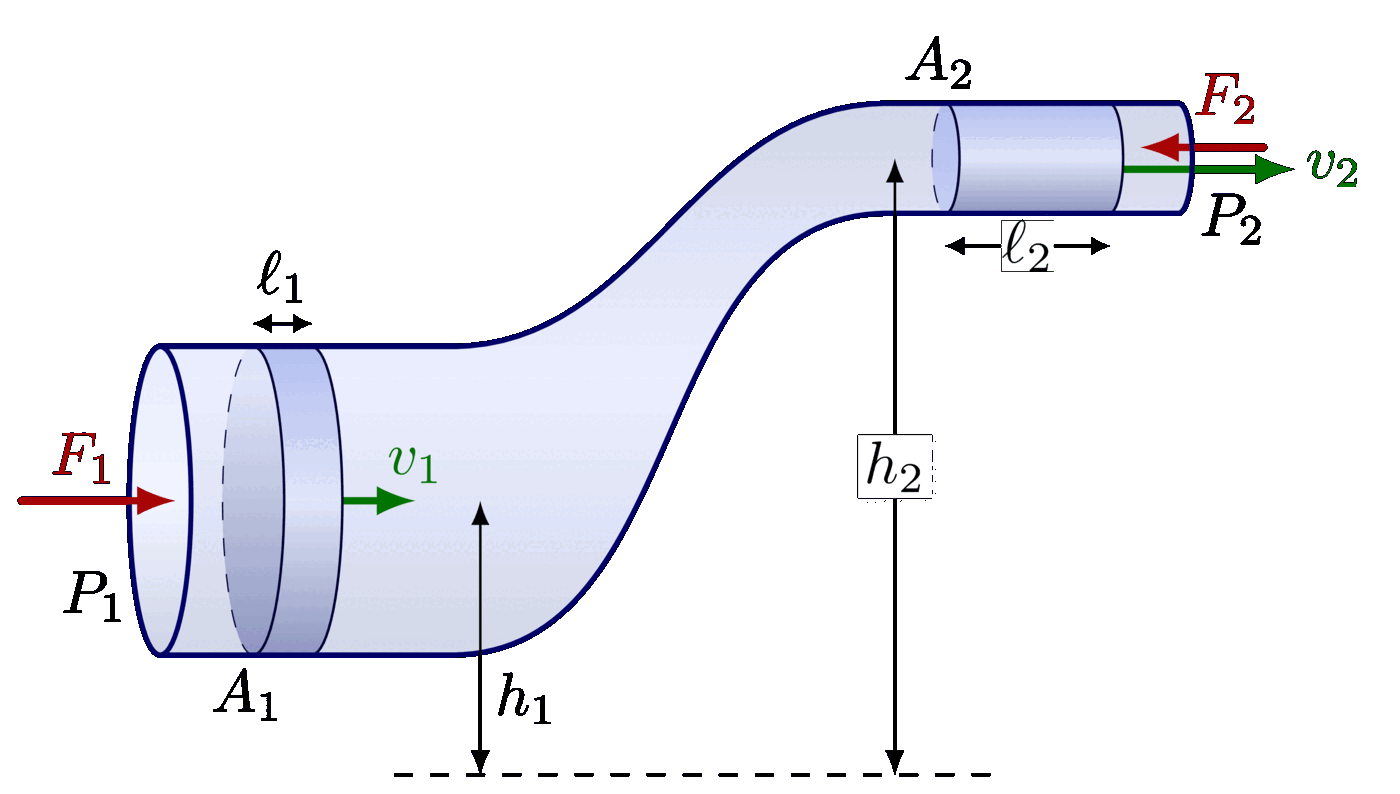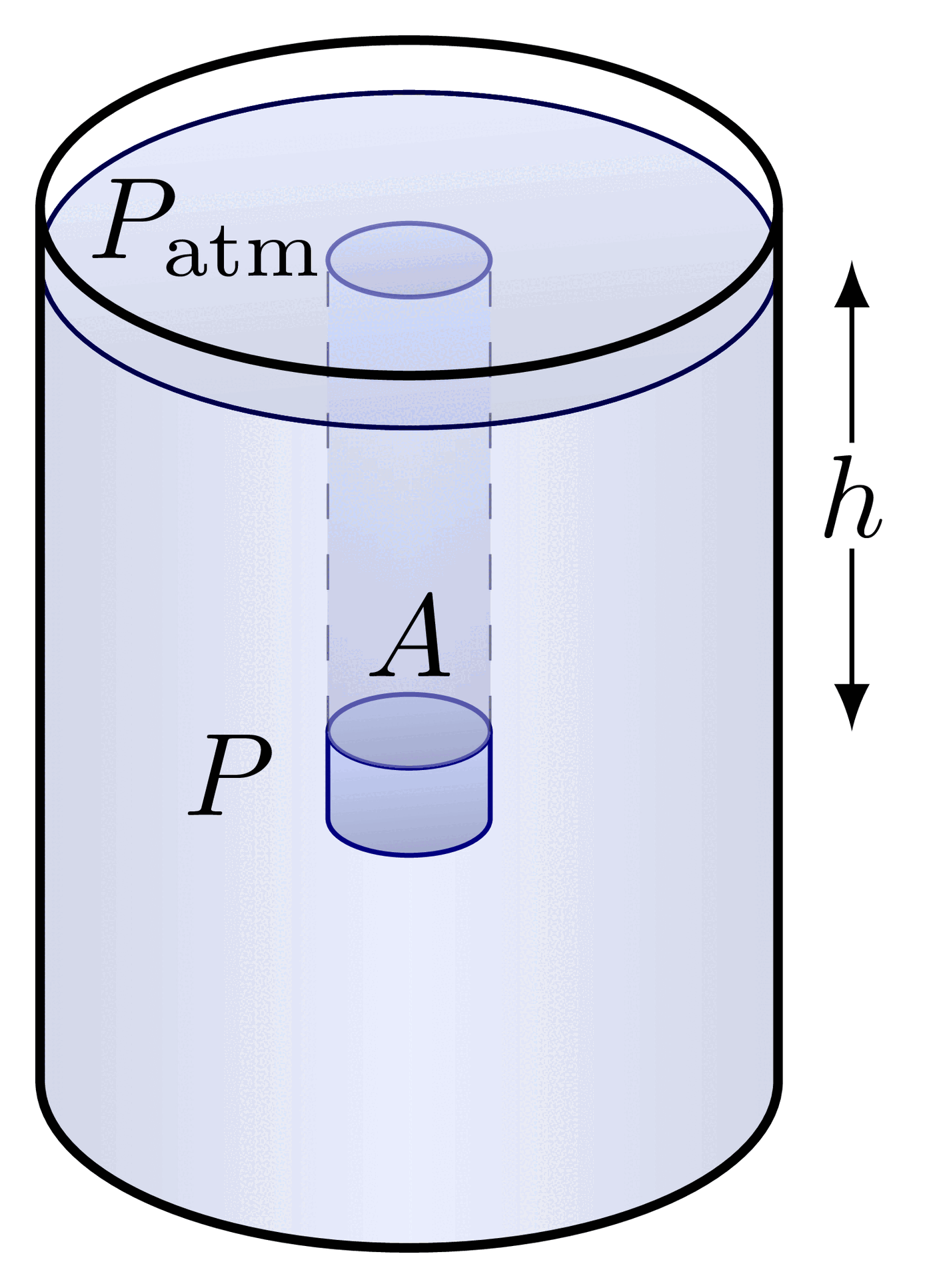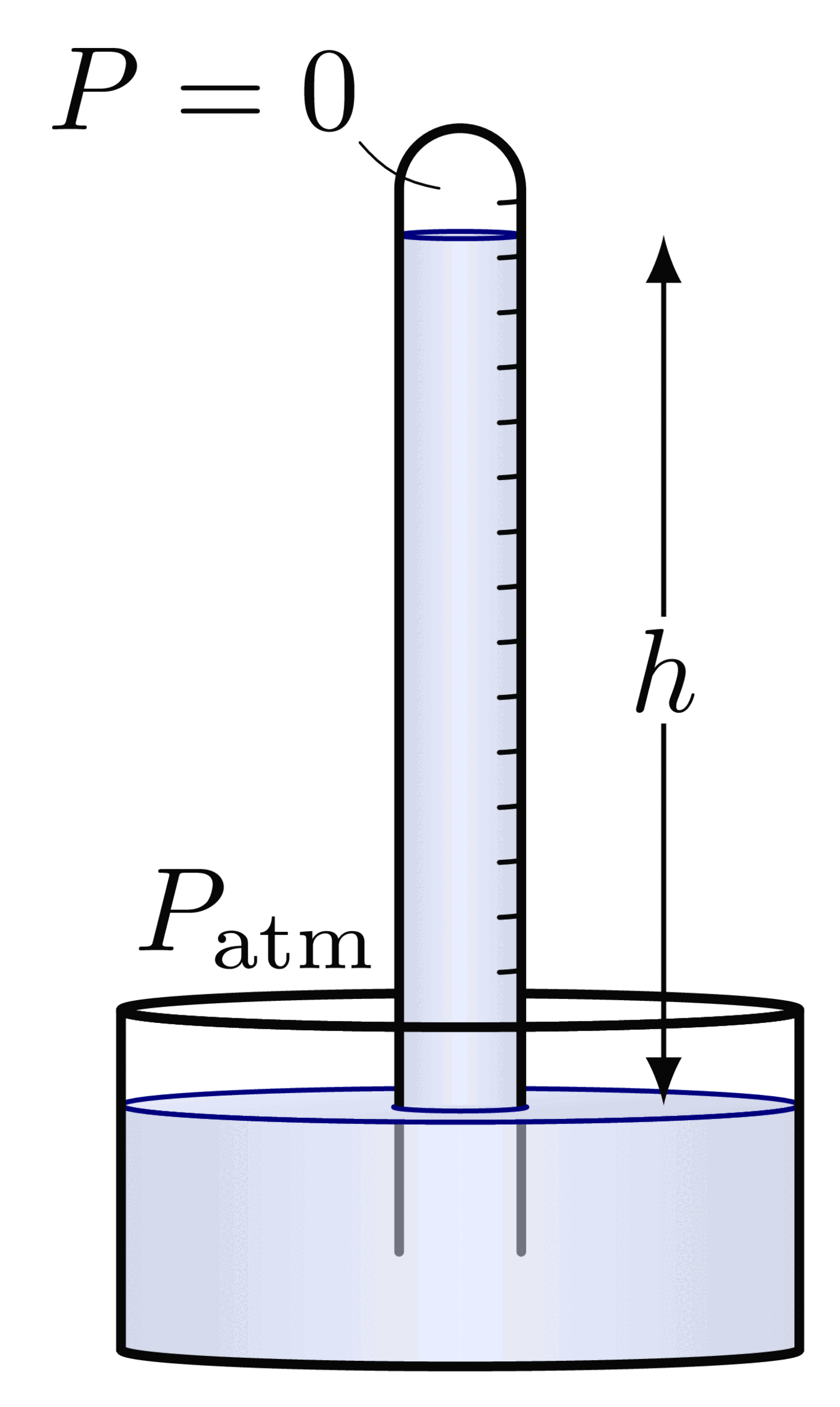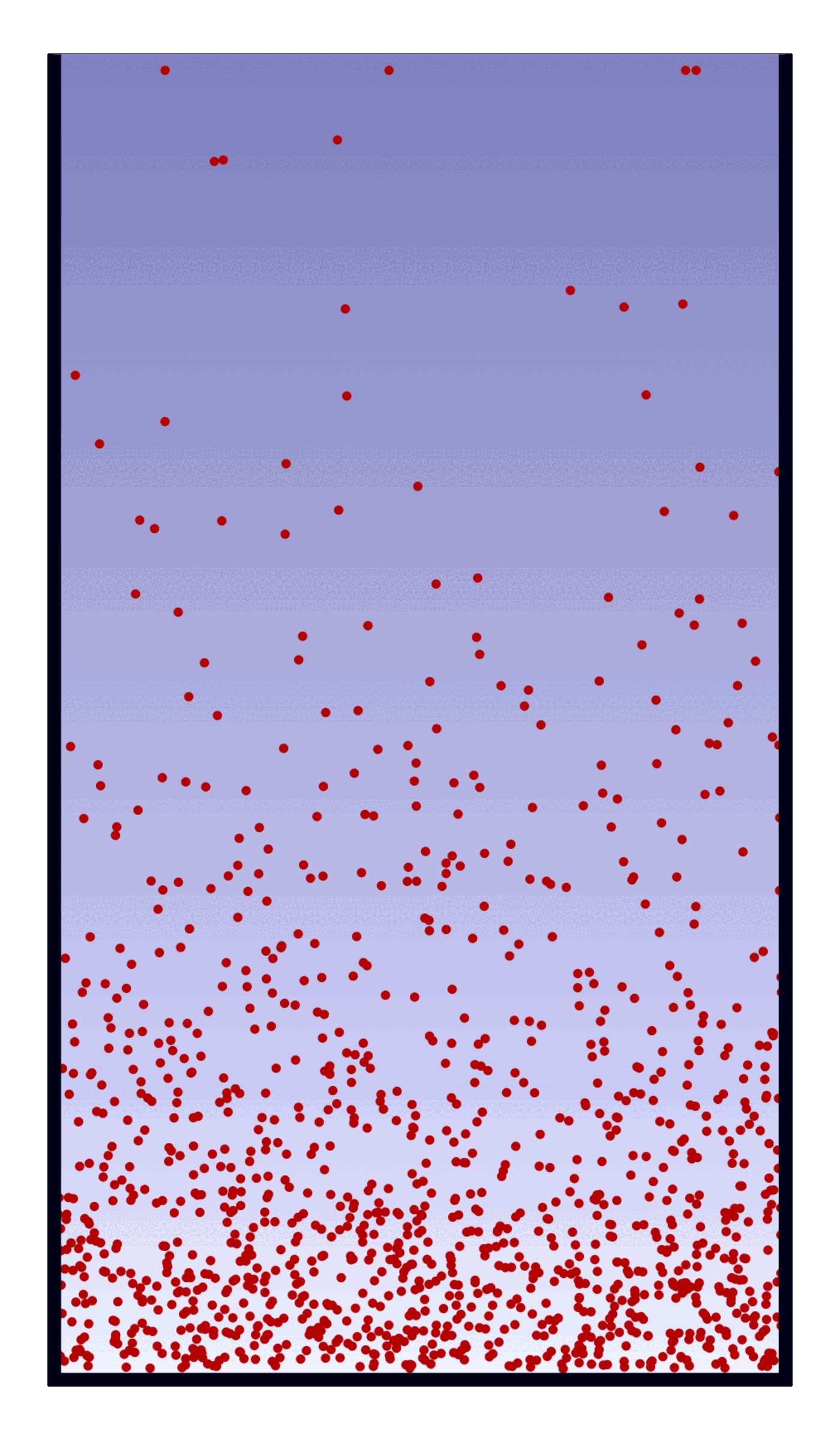Venturi effect raising a column of liquid. Also see this diagram on Bernouilli’s Principle, or for more related figures, please have a look at the Fluid Dynamics category.
Edit and compile if you like:
% Author: Izaak Neutelings (November 2020)
\documentclass[border=3pt,tikz]{standalone}
\usepackage{physics}
\usepackage{tikz}
\usepackage[outline]{contour} % glow around text
\tikzset{>=latex}
\contourlength{0.9pt}
\colorlet{mydarkblue}{blue!40!black}
\colorlet{myblue}{blue!30}
\colorlet{myred}{red!65!black}
\colorlet{vcol}{green!45!black}
\colorlet{watercol}{blue!80!cyan!10!white}
\colorlet{darkwatercol}{blue!80!cyan!80!black!30!white}
\tikzstyle{water}=[mydarkblue,top color=watercol!90!black!80,bottom color=watercol!90!black!90,middle color=watercol!80,shading angle=10]
\tikzstyle{air}=[mydarkblue,top color=watercol!90!black!6,bottom color=watercol!90!black!6,middle color=watercol!6,shading angle=0]
\tikzstyle{vvec}=[->,very thick,vcol,line cap=round]
\tikzstyle{force}=[->,myred,very thick,line cap=round]
\tikzstyle{width}=[{Latex[length=3,width=3]}-{Latex[length=3,width=3]}]
\begin{document}
% VENTURI EFFECT
\begin{tikzpicture}
\def\L{3.1} % large pipe length
\def\l{3.6} % small pipe length
\def\m{0.22*\L} % length pipe middle
\def\Rx{0.20} % big pipe vertical radius right
\def\Ry{1.00} % big pipe vertical radius right
\def\rx{0.08} % small pipe horizontal radius left
\def\ry{0.40} % small pipe vertical radius left
\def\t{0.19} % vertical pipe radius
\def\h{1.5} % vertical pipe height
\def\d{0.12} % vertical pipe depth in water
\def\y{1.0} % height fluid column
\def\W{2.3} % width bath top
\def\w{1.9} % width bath bottom
\def\H{0.9} % height bath
\def\v{0.45} % velocity magnitude
\def\xr{\L+\m+0.08*\l} % ring x position
% WATER
\draw[dashed] (\L+\m+0.115*\l,-\ry-\h+2*\d-\H) --++ (0.79*\l,0);
\begin{scope}
\clip (\L+\m+\l/2-\W/2,-\ry) --++ (0,-\h+2*\d) --++ (\W/2-\w/2,-\H) --++ (\w,0) --++
(\W/2-\w/2,\H) --++ (0,\h-2*\d) -- cycle;
\draw[water,draw=none]
(\L+\m+\l/2-\t,-\ry-\h+\d) |-++ (2*\t,\h) |-++ (\W/2-\t/2,-\h) |-++ (-\W,-\H) |- cycle;
\end{scope}
\draw[mydarkblue!80!black,thick,line cap=round]
(\L+\m+\l/2-\W/2,-\ry-\h+2*\d) --++ (\W/2-\w/2,-\H) --++ (\w,0) --++ (\W/2-\w/2,\H);
% AIR
\fill[air]
(0,\Ry) --++ (\L,0) to[out=0,in=180] (\L+\m,\ry) --++ (\l,0) arc(90:-90:{\rx} and \ry)
-|++ (-\l/2+\t,-\h+\y) -|++ (-2*\t,\h-\y) -- (\L+\m,-\ry) to[out=180,in=0] (\L,-\Ry) -- (0,-\Ry);
\draw[mydarkblue!80!black,thick,line cap=round]
(0,\Ry) --++ (\L,0) to[out=0,in=180] (\L+\m,\ry) --++ (\l,0) arc(90:-90:{\rx} and \ry)
-|++ (-\l/2+\t,-\h)
(\L+\m+\l/2-\t,-\ry-\h) --++ (0,\h) -- (\L+\m,-\ry) to[out=180,in=0] (\L,-\Ry) -- (0,-\Ry);
\draw[air,thick]
(0,0) ellipse({\Rx} and \Ry);
\draw[dashed] (\L+\m+0.115*\l,-\ry-\h+\y) --++ (0.79*\l,0);
% VELOCITIES
\draw[vvec] (0.45*\L,0) --++ (\v,0) node[right=-2] {$v_\mathrm{A}$};
\draw[vvec] (\L+\m+0.23*\l,0) --++ (\v*\Ry/\ry,0) node[right=-2] {$v_\mathrm{B}$};
% HEIGHTS
\draw[opacity=0.5] (\xr,\ry) arc(90:-90:{\rx} and \ry);
\draw[opacity=0.5,dashed] (\xr,\ry) arc(90:270:{\rx} and \ry);
\draw[->] (0,0) --++ (0,\Ry) node[midway,left=-1] {\contour{white}{$R_\mathrm{A}$}};
\draw[->] (\xr,0) --++ (0,\ry) node[pos=0.4,left=-1] {$R_\mathrm{B}$};
\draw[<->] (\L+\m+0.13*\l,-\ry-\h+2*\d-\H) --++ (0,\H-2*\d+\y) node[midway,left=-2] {$h_\mathrm{D}$};
\draw[<->] (\L+\m+0.87*\l,-\ry-\h+2*\d-\H) --++ (0,\H-\d) node[midway,right=-1] {$h_\mathrm{E}$};
\draw[<->] (\L+\m+0.87*\l,-\ry-\h+\d) --++ (0,\y-\d) node[midway,right=-1] {$h_\mathrm{D}-h_\mathrm{E}$};
% POINTS
\fill (0.24*\L,-0.3*\Ry) circle(0.04) node[below=0] {A};
\fill (\L+\m+0.78*\l,0) circle(0.04) node[right=0] {B};
\fill (\L+\m+\l+3*\rx,0) circle(0.04) node[right=0] {C};
\fill (\L+\m+0.50*\l,-\ry-\h+\y) circle(0.04) node[above=0] {D};
\fill (\L+\m+0.65*\l,-\ry-\h+\d) circle(0.04) node[above=0] {E};
\end{tikzpicture}
\end{document}
Click to download: fluid_dynamics_venturi.tex • fluid_dynamics_venturi.pdf
Open in Overleaf: fluid_dynamics_venturi.tex


